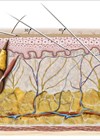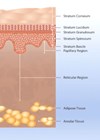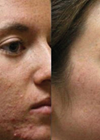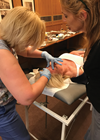It is well documented that colder temperatures can have detrimental effects on the skin [1]. Individuals living in countries far from the equator, such as northern parts of Europe and North America are exposed to harsh weather during winter months, which may exacerbate existing inflammatory skin conditions, as well as triggering symptoms of dry skin [2].
Typically, low temperatures, as well as low humidity can lead to a decrease in skin barrier function and heightened susceptibility to incurring mechanical stress and increased shearing [1]. Consequently, this results in pro-inflammatory cytokines and cortisol being released, as well as an increase in the number of dermal mast cells [3]. This can result in skin becoming increasingly reactive to skin irritants and allergens, particularly in patients with atopic dermatitis [4].

This article will outline some of the available treatments with both corrective and preventative benefits to improve the resilience of the skin against the effects of cold weather. A bespoke regimen can be tailored with consideration to the following key factors: the condition of the skin barrier, anatomical area to be treated, frequency of attending clinic appointments, specified budget, and expected timeframe to achieve desired results.
The treatments and topical ingredients that are outlined are not intended to be exhaustive, but can be considered both as standalone, and combination approaches.
LED phototherapy
LED phototherapy provides an affordable and effective treatment for all skin types, and can be used to treat a diverse range of skin concerns on the face and body [5]. The mechanisms of action are based on the same principles as photosynthesis, known as photobiomodulation, which means that light is absorbed by target cells to activate specific cellular biological functions [6]. A number of critical factors are important considerations for LED treatment to be clinically effective, such as, the correct wavelength, dose, energy and exposure time [7].
LED phototherapy positively impacts cellular metabolism by triggering intracellular photobiochemical reactions, which include increased adenosine triphosphate (ATP), modulation of reactive oxygen species, stimulation of angiogenesis and increased blood flow among others [8]. LED phototherapy can successfully trigger a variety of regenerative processes to improve conditions such as rosacea, acne, psoriasis, eczema, dermatitis, wound healing, dry / irritated skin, as well as musculoskeletal disorders [9].
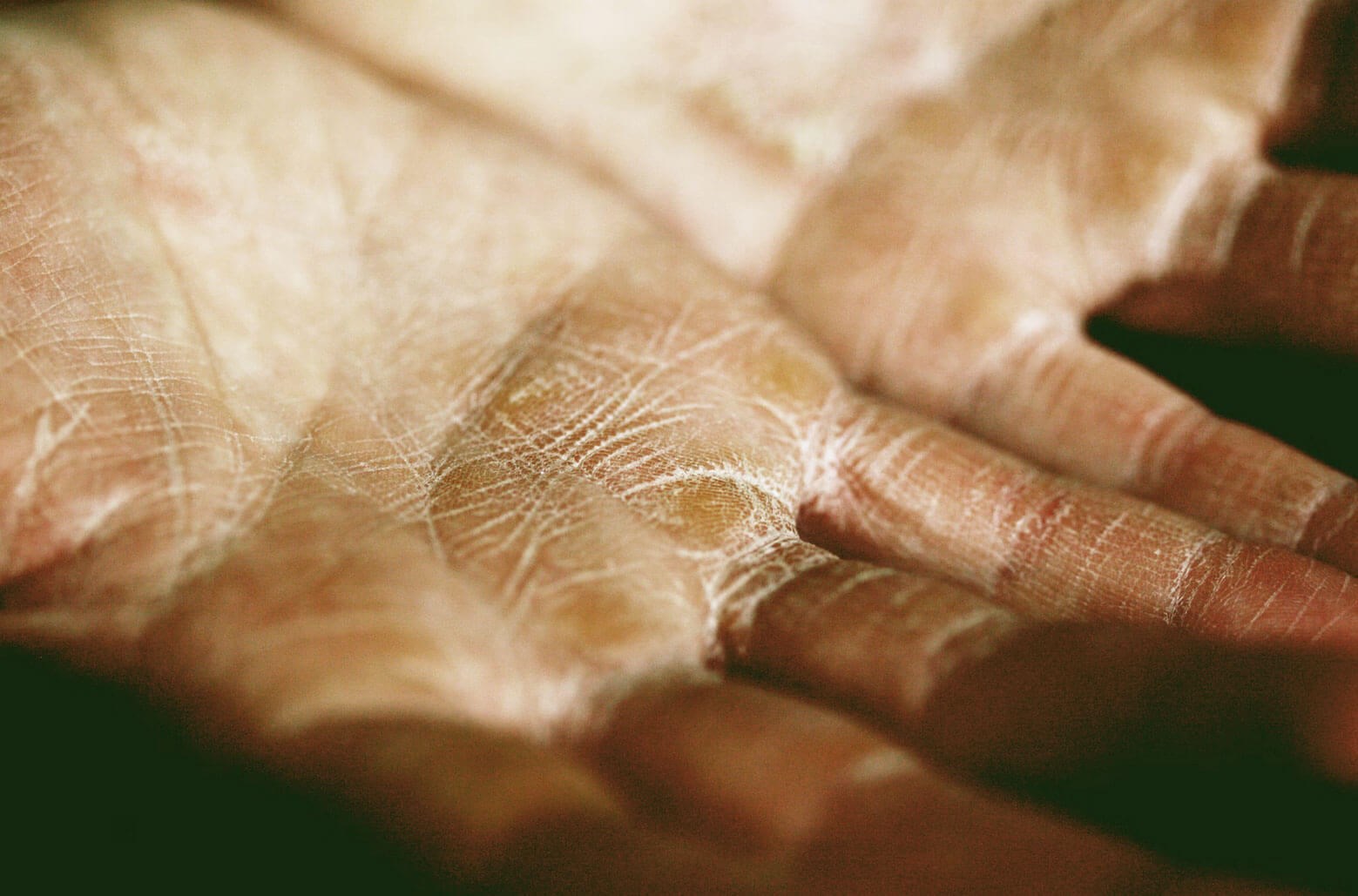
The two most beneficial wavelengths to combat the effects of winter on skin are red (633nm) and near-Infrared (830nm). Red light 633nm is proven to stimulate collagen and elastin synthesis, as well as improve texture and roughness, while reducing the appearance of fine lines [10]. Red light specifically at 633nm can penetrate at 8-10mm in the mid-dermis, and recharges ATP to help enhance and restore optimal cell function and stimulate cell renewal [11]. It also helps to reduce hyperpigmentation, increase skin hydration, and stimulate blood circulation, which is key to improve dryness and dullness in winter months [11].
Near-infrared (NIR) light 830nm provides advanced skin rejuvenation benefits by modulating inflammation and accelerating healing, and can be used on sensitive skin [7]. NIR 830nm is outside of the visible light spectrum and is invisible to the naked eye, but can penetrate to the subcutaneous layer between 20-100mm [10]. This wavelength is especially useful at calming and stabilising a sensitive, or disrupted skin barrier, which is a frequent concern in colder weather. Red and NIR wavelengths can be considered to have both corrective and preventative benefits for these types of concerns, and can be used synergistically depending on the technology of the LED device.
LED treatment is contraindicated in those who are diagnosed with epilepsy or seizures which are triggered by light. It is also contraindicated in individuals with porphyria, autoimmune conditions, polymorphic light eruption, photosensitive eczema and active cancers [5]. Caution is advised with patients who are pregnant and assessment is recommended to be performed on a case-by-case basis considering risk versus benefit in proceeding with treatment. Additionally, individuals with eye disease, light-induced migraines, as well as those taking photosensitising medications and / or prescribed skincare products, including St John’s Wort, may not be suitable for LED treatment [6].
Mesotherapy
Hyaluronic acid (HA) is a linear polysaccharide, composed of repeating disaccharide units within the extracellular matrix of all vertebrate tissues [12]. More than 50% of the HA in our body is located within the skin where it is synthesised by fibroblasts, keratinocytes, and endothelial cells of the dermal micro-circulation in many variants of different molecular weights [13]. It plays many important roles, ranging from facilitating tissue repair, maintaining cellular homeostasis, to exerting a dermal scaffolding effect due to its high affinity to bind and retain water [12]. HA decrease in aged skin contributes to dryness, dermal thinning and the formation of wrinkles [14].
Mesotherapy is an effective and simple method to restore optimal HA hydration levels to skin on the face, neck and body. Mesotherapy can be considered as a form of biorevitalisation as it not only improves the moisture levels in the superficial layers of the skin, but can improve skin brightness, as well as signs of photodamage [15]. Biorevitalising complexes typically combine a linear (non-stabilised) hyaluronic acid with a specific combination of amino acids, vitamins and minerals [16]. Some formulations may be premixed and ready to use and one of the principle benefits of mesotherapy is that the HA carrier effectively hydrates the extracellular matrix, allowing the additional ingredients to stimulate key ECM proteins through stimulating fibroblasts [17]. The biorevitalising effect that is achieved through a course of treatment is due to the different biological effects of the cocktail of ingredients [17]. An initial course, as well as maintenance treatments can provide corrective as well as preventative benefits, effectively hydrating the skin and promoting a healthy cellular environment.
Bioremodelling
Bioremodelling is a process which triggers a regenerative cascade through the three main layers of the skin. This involves a novel technology that utilises a patented hybrid, stabilised, injectable hyaluronic acid technology to address signs of poor skin quality and areas of laxity [18]. The injectable treatment is based on stable hybrid cooperative complexes of high-and low-molecular-weight HA (H-HA and L-HA), without the addition of chemical cross-linking agents [19]. This is formulated in high concentrations of 64mg in a 2ml syringe for the face and neck, and 96mg in a 3ml syringe for areas on the body. An initial course of two to three treatments, at a one-month interval, elicits regenerative benefits to improve elasticity, hydrate, tighten and firm the skin, which effectively alleviates seasonal dryness and dullness.
Topical ingredients
A moisturising topical regimen can effectively improve dry and irritated skin, often discounting the need for additional treatments [20]. A bespoke skin regimen is arguably an important part of any treatment pathway, which can be customised according to the condition / areas treated, specified budget, compliance, as well as the season. Individual preference may favour certain vehicle preparations, such as a lotion, instead of a cream. In general moisturising agents may be grouped into: emollients, humectants, occlusives and protein rejuvenators. Judicious use of these will enable optimum treatment of the different skin conditions [21]. The facial cleanser, bionic lotion and daytime protection cream, from the Restore skincare range by NEOSTRATA®, are examples of products which can be recommended for combating winter skin as they are gentle and hydrating.
Hyaluronic acid
Hyaluronic acid has been a popular ingredient in many skincare formulations for some time, but can be considered contentious owing to the molecule size, and whether it can reach a target layer in the skin [22]. It is increasingly understood that size matters when it comes to HA, and it can be argued that traditional formulations containing large molecular sizes of HA may not easily penetrate the stratum corneum offering little clinical benefit, beyond providing a superficial level of hydration to the skin. Newer technologies can be categorised into high molecular weight and low molecular weight HA in terms of their mode of actions as high molecular weight offers a protective effect and maintains skin integrity, whereas low molecular weight offers optimal skin hydration owing to its hygroscopic properties [23]. These topical properties may soothe and hydrate dry and irritated skin with the added benefit of humectant characteristics, as well as an inherent biocompatibility [24].
Ceramides
Ceramides have become increasingly recognised as key ingredients in moisturisers for more than 15 years, and can be considered to be one of the most important barrier lipids to facilitate waterproof characteristics to the skin barrier [25]. Ceramides are a complex group of sphingolipids composed of sphingosine bases, fatty acids and amide linkages. Draelos (2020) describes nine major classes of free ceramides, and two major protein-bound ceramides covalently bonded to corneocyte protein envelopes (Cer A and Cer B) [25]. Topical treatment with ceramides may be particularly beneficial for treating atopic dermatitis as these can increase skin barrier resistance and reduce skin susceptibility to irritants and increased trans-epidermal water loss.
Gluconolactone
Gluconolactone is a poly-hydroxy acid with a number of corrective and preventative anti-ageing benefits [26]. It has comparable efficacy to alpha-hydroxy acids, but is compatible and well tolerated on atopic and sensitive skins [26]. Gluconolactone provides effective humectant and moisturisation benefits and enhances the stratum corneum barrier function with antioxidant benefits [27]. In addition, it has proven photoprotective benefits, comparable to both vitamin C and E [27]. Its closely related counterpart ingredients, lactobionic and maltobionic acid, are bionic acids which share similar multi-mechanism benefits as gluconolactone, and are also popular choices for their advanced anti-ageing and restorative properties on sensitive skins[28].
Niacinamide
Nicotinic acid (niacin) and niacinamide (often known as nicotinamide) share similar positive benefits as they can be converted into each other within an organism, or cell; niacinamide is the amide form of vitamin B3 [29]. Topical uses of niacinamide are diverse. Sensitive skins benefit from the stabilising effect on epidermal barrier function, reductions in transepidermal water loss and an improvement in the moisture content of the horny layer [29]. Niacinamide elicits anti-inflammatory effects, speeds up differentiation of keratinocytes and facilitates stimulation of ceramide synthesis [30]. It is also a popular ingredient choice to correct hyperpigmentation as it inhibits melanosome transfer from melanocytes to keratinocytes and demonstrates effective skin lightening properties [29].
Conclusion
Medical aesthetic practitioners are well placed to manage many seasonal effects which impact skin on the face and body during cooler months, with a variety of topical and procedural approaches. Many combined treatment regimens may continue long term, which can improve the health of the skin barrier all year round as well as provide additional anti-ageing benefits.
References
1. Engrebretsen KA, Johansen JD, Kezic S, et al. The effect of environmental humidity and temperature on skin barrier function and dermatitis. J Eur Acad Dermatol Venereol 2015;30(2):223-49.
2. Dolečková I, Čápová A, L Machková , et al. Seasonal variations in the skin parameters of Caucasian women from Central Europe Skin Res Technol 2021;27(3):358-69.
3. Goad N, Gawkrodger DJ. Ambient humidity and the skin: the impact of air humidity in healthy and diseased states. J Eur Acad Dermatol 2016;30(8):1285-94.
4. Yosipovitch G, Misery L, Proksch E, et al. Skin Barrier Damage and Itch: Review of Mechanisms, Topical Management and Future Directions. Acta Derm Venereol 2019:99(13):1201-9.
5. Glass GE. Photobiomodulation: The Clinical Applications of Low-Level Light Therapy. Aesthetic Surgery Journal 2021;41(6):723-38.
6. Zein R, Selting W, Hamblin MR. Review of light parameters and photobiomodulation efficacy: dive into complexity. Journal of Biomedical Optics 2018;23(12):120-1.
7. Poel DR, Hagstrom E, Pace AK, et al. Light-emitting Diodes. The Journal of Clinical and Aesthetic Dermatology 2015;8(6):36-44.
8. Calderhead RG, Vasily DB. Low Level Light Therapy with Light-Emitting Diodes for the Aging Face. Clin Past Surg 2016;43(3):541-50.
9. Freitas LFD, Hamblin MR. Proposed mechanisms of photobiomodulation or low-level light therapy. IEEE J. Sel. Top. Quantum Electron 2016;22(3):348-64.
10. Baker A. Exploring LED Phototherapy. Aesthetics 2022;9(4):23-4.
11. Wunsch A, Matuschka K. A controlled trial to determine the efficacy of red and near-infrared light treatment in patient satisfaction, reduction of fine lines, wrinkles, skin roughness, and intradermal collagen density increase. Photomed Laser Surg 2014;32(2):93-100.
12. Beatini A, Persini P, Russo R. ‘REAL LIFE’ efficacy evaluation of a new hyaluronic acid gel suitable for deep hydration and fine wrinkles correction. Aesthetic Medicine 2019;5(3):22-7.
13. Fraitag S, Prost-Squarcioni C, Heller M, Boehm N. Functional histology of dermis. Ann Dermatol Venereol 2008;135(1Pt2):191-201.
14. Humzah D, Romagnoli M, Tateo A, Bellia G. Hyaluornic acid: a strategic molecule for rejuvenating procedures. Ezperienze Dermatologiche 2020;22(4):36-41.
15. Sparavigna A, Tenconi B, De Ponti I. (2015) Antiaging, photoprotective, and brightening activity in biorevitalization: a new solution for aging skin. Clinical, Cosmetic and Investigational Dermatology 2015;8:57-65.
16. Lee JC, Daniels MA, Roth MZ. Mesotherapy, microneedling, and chemical peels. Clin Plast Surg 2016;43(3):583-95.
17. Iorizzo M, De Padova MP, Tosti A. Biorejuvenation: theory and practice. Clin Dermatol 2008;26(2):177-81.
18. Laurino C, Palmieri B, Coacci A. Efficacy, Safety, and Tolerance of a New Injection Technique for High-and Low-Molecular-Weight Hyaluronic Acid Hybrid. Complexes eplasty 2015;15:46.
19. Cassuto D, Delledonne M, Zaccaria G, et al. Safety Assessment of High-and Low-Molecular-Weight Hyaluronans (Profhilo) as Derived from Worldwide Postmarketing Data. BioMed Research International 2020. Epub online ahead of print.
20. Moniaga CS, Tominaga M, Takamori K. Mechanisms and Management of Itch in Dry Skin. Acta Dermato-Venereologica 2020;100(2):adv00024.
21. Purnamawati S, Indrastuti N, Danarti R, Saefudin T. The Role of Moisturizers in Addressing Various Kinds of Dermatitis: A Review. Clin Med Res 2017;15(3-4):75-87.
22. Ratajczak P, Maciejak O, Kopciuch D, et al. Directions of hyaluronic acid application in cosmetology. J Cosmet Dermatol 2022. Epub online ahead of print.
23. Cestone E, Bellia G, Nobile V, et al. Evaluation of the anti-ageing efficacy of Hilow Haenkenium cream in healthy woman Aesthetic Medicine 2020;6(1):25-33.
24. Salwowska NM, Bebenek KA, Zadlo DA, Wcislo-Dziadecka DL. Physiochemical properties and application of hyaluronic acid: a systematic review Journal of Cosmetic Dermatology 2016;15(4):520-6.
25. Draelos ZD, Baalbaki NH, Cook S, et al. The Effect of a Ceramide-Containing Products on Stratum Corneum Lipid Levels in Dry Legs. Journal of Drugs in Dermatology 2020;19(4):372-6.
26. Jarzabek-Perz S, Mucha P, Rotsztejn H. Corneometric evaluation of skin moisture after application of 10% and 30% gluconolactone. Skin Research & Technology 2021;27(5):925-30.
27. Bernstein EF, Brown DB, Schwartz MD, et al. The Polyhydroxy Acid Gluconolactone Protects Against Ultraviolet Radiation in an In Vitro Model of Cutaneous Photoaging. Dermatologic Surgery 2004;30(2):189-96.
28. Green BA, Edison BL, Wildnauer RH. Maltobionic acid, a plant-derived bionic acid for topical anti-aging. Am Acad of Dermatol 2006;54(3):AB37.
29. Rolfe HM. A review of nicotinamide: treatment of skin diseases and potential side effects. Journal of Cosmetic Dermatology 2014;13(4):324-8.
30. Gehring W. Nicotinic acid/niacinamide and the skin. Journal of Cosmetic Dermatology 2004;3(2):88-93.
COMMENTS ARE WELCOME




